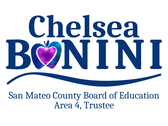|
Federal Funding for special education is NOT sufficient… and it never has been.
You can submit comments to the California Department of Education (CDE), Special Education Division, regarding its preliminary application for Federal Fiscal Year (FFY) 2022 federal funding under the Individuals with Disabilities Education Act (IDEA), as Amended in 2004, Public Law 108-446. The CA application is available for 60 days and public written comment will be accepted for at least 30 days prior to submission to the U.S. Department of Education, Office of Special Education Programs (OSEP). Written comments will be accepted from April 1 to May 2, 2022. See: https://www.cde.ca.gov/sp/se/as/fndapp22.asp... Your voice matters. #forkids #forteachers #opportunity #inclusion #accountability
0 Comments
Even pre-pandemic, our students were experiencing rising levels of mental health diagnoses which were frequently not addressed adequately in our schools, and in the wake of the pandemic, this crisis has worsened.If you are a teacher or work with kids in San Mateo County and have not yet been trained in YOUTH MENTAL HEALTH FIRST AID, you can find out more & enroll here: https://www.smchealth.org/.../youth-mental-health-first-aid #forkids #forfamilies #forcommunity #forSanMateoCounty #EveryDay [See Article]
Teachers are the most important component of the plan for Universal Transitional Kindergarten (UTK).
"School districts across the state are scrambling to hire an estimated 11,000 teachers and 25,000 teacher assistants to expand transitional kindergarten. It’s a tall order for school district officials already in the midst of a daunting educator shortage and coming out of the pandemic. “If we can’t find staffing, we just flat can’t do it,” said Mike Martin, superintendent of the County Office of Education in Modoc County. “It’s not like we have a pool of folks lined up asking to come to work in our districts. We are competing with everybody else out there for these same folks.”" https://calmatters.org/education/k-12-education/2022/03/california-teacher-shortage-pre-kindergarten/ As a kindergarten teacher prior to California's mid-90's "standards" implementation, which essentially made allocating time for play in kindergarten much more challenging, I know first-hand that this study is "spot on" in its findings. Play is essential for growing brains and development of social interaction skills. And for those that do not know, I was essentially teaching Pre-K/TK, whatever you want to call it in today's terms, in circa 1994. And now we realize that ratcheting up academics in Kindergarten caused parents to enroll kids a year later (turning 6, rather than turning 5)... and many of our youngest learners lost out on this essential year of early learning. We're trying to course correct now, which I am thankful for, but we should really make better decisions going forward.💜 #ForKids #ForFamilies #ForEquity #Opportunity #Inclusion #Accountability https://hechingerreport.org/kids-can-learn-more-from-guided-play-than-from-direct-instruction-report-finds/?_cldee=Y2JvbmluaUBzbWNvZS5vcmc%3d&recipientid=contact-7734becfe9e4e41180e2005056b02a09-44081c6b1eda4bcaba2e4e8184d9e2f4&esid=393f64d2-51ac-ec11-814e-005056b02a09
On Friday, March 18, 2022, our San Mateo County Board of Education had a Budget Study Session to hear how the County Office of Education is developing and managing the budget. I learned more about how our Board has historically been very diligent in reviewing and approving the SMCOE budget. We had a great conversation about our continuing need to advocate for increased and fair funding for education, especially in regard to retaining the $28M that the State currently sweeps from our SMCOE "excess property taxes"... if you're interested in knowing more about that, let me know! #Advocating #ForKids #ForSanMateoCounty
As a parent in the San-Mateo Foster City School District since 2009, as a former Board Trustee for our District (2013-2017), and in my current role on the San Mateo County Board of Education, I have had frequent conversations with stakeholders about how we might better serve kids who are diagnosed (or may need to be diagnosed) with dyslexia in our public schools.
There is no lack of research around how to serve students with dyslexia, and indeed, the State of California developed Guidelines for serving students with dyslexia back in 2017, with the stated purpose of "assist[ing] regular education teachers, special education teachers, and parents in identifying, assessing, and supporting students with dyslexia." The Guidelines drew upon "both current research and the collective professional wisdom and experience of the members of the Dyslexia Guidelines Work Group." The San Mateo County SELPA Director shared the State Guidelines and recommended practices with our County's school districts following their release, as she was a participant in the Dyslexia Guidelines Work Group and understood the impact of their application. We know that early dyslexia identification and implementation of teaching strategies for intervention are very important and require a "concerted and relentless effort" to implement. If your District is leading in this effort, I'd love to know more about it, as well as if you'd like more information on this issue, please feel free to contact me. Widespread implementation of best practices for early dyslexia identification and implementation of teaching strategies will help us reach our shared goal of ensuring that all kids in San Mateo County have a strong foundation for lifelong learning. Chelsea Bonini San Mateo County Board of Education, Trustee *All references herein are to the California Dyslexia Guidelines As local entities engage in the process of redistricting their area boundaries following the 2020 Census, the San Mateo County Board of Education's new area lines will be decided upon by the County Committee on School District Organization (the CCSDO), with the Board of Education having only an ability to offer public comment and submit recommendations as members of the public.
The suggested new map brought forth by the CCSDO is most impactful in altering my Area 4, as it is currently aligned with the boundaries of the San Mateo-Foster City School District, which is the most populous school district in the County. Area 4 will have to be divided, but the question is how should we address this. The decision on the new County Board of Education Trustee Area boundaries will be made in March 2022. See: CCSDO Presentation to the San Mateo County Board of Education - January 19, 2022 Your opportunity to provide input has come!
Subject: Input Request California Special Education Local Plan Area (SELPA) Community Advisory Committee Guide, 5th Ed. (2021) Dear CAC Members, SELPA, CDE, Parent Centers, and related partners, Please respond to the enclosed survey which is a request for feedback and input related to updating a California Special Education Local Plan Area (SELPA) Community Advisory Committees (CACs) resource. A review and revision committee has updated the original sections of the “CAC Community Advisory Committee Guidelines” Fourth Edition 2011 and are now seeking additional input and feedback from CAC members, SELPA, CDE, Parent Centers, and related partners. Information you share is important and will enhance the collaborative effort of creating the California Special Education Local Plan Area (SELPA) Community Advisory Committee Guide, 5th Ed. (2021). This resource is currently separated into eight sections: Section 1: Legislative Mandate for CACs Section 2: CAC Responsibilities and Activities Section 3: Effective CACs Section 4: Components of Successful CACs Section 5 Implementing Best Practices Section 6: Action Plans Section 7: Local Plan Section 8 General Related Agencies and Resources Please provide any feedback and input at the bottom of each survey section, there is also a general comments space toward the end of the survey. In an effort to acknowledge suggestions received as well as have a way to contact you should clarification on your input be needed; the opening survey page asks a few questions about individuals providing input. You must click “submit” at the end of the survey for your feedback to be recorded. Please note, section content is draft and not meant for further distribution beyond this survey purpose at this time. Thank you for taking the time to contribute your feedback and input as part of updating this resource. The survey link will be open until 1/31//2022. English Survey Link: https://forms.gle/V5RF7cDBPRYSLkon8 Spanish Survey Link: https://forms.gle/GXTsQgfa4G9uMxUE8 Thank you, California SELPA CAC Guide, 5th Ed. Review and Revision Committee *This email and opportunity to provide feedback and input was sent to contacts within the various groups mentioned above, please share with related colleagues you feel may not have received it directly, their input is equally valued. **** Para leer este correo electrónico en español, vea a continuación. Solicitud de opinión: Guía para el Comité Asesor de la Comunidad del Área de plan local de educación especial (SELPA) de California, 5ª ed. (2021) Les pedimos que respondan a la encuesta adjunta, que solicita su opinión y comentarios sobre la actualización de un recurso para los Comités Asesores Comunitarios (CAC) del Área local de planificación para la educación especial (SELPA) en California. Un comité de repaso y revisión ha actualizado las secciones originales de las “Pautas para el Comité Asesor de la Comunidad (CAC)”, cuarta edición, 2011, y ahora está solicitando opiniones y comentarios adicionales de los miembros del CAC, SELPA, CDE, Centros de Padres y otros socios. La información que comparta con nosotros es importante y realzará el esfuerzo colaborativo para crear la Guía para el Comité Asesor de la Comunidad del Área de plan local de educación especial (SELPA) de California, 5ª edición (2021). Este recurso está dividido actualmente en ocho secciones: Sección 1: Mandato legislativo para los CAC Sección 2: Responsabilidades y actividades del CAC Sección 3: CACs eficaces Sección 4: Componentes de CACs exitosos Sección 5: Cómo implementar las mejores prácticas Sección 6: Planes de acción Sección 7: Plan local Sección 8: Agencias y recursos generales asociados Por favor ponga su opinión y sus comentarios al pie de cada sección de la encuesta. También hay un espacio para comentarios generales al final de la encuesta. Con el fin de reconocer las sugerencias recibidas y poder ponernos en contacto con usted en caso de que necesitemos aclaraciones sobre sus comentarios; la página inicial de la encuesta contiene algunas preguntas sobre los individuos participantes. Tiene que hacer clic en “enviar” al final de la encuesta para poder registrar sus comentarios. Tenga en cuenta que el contenido de cada sección es un borrador y no se debe distribuir para ningún otro fin que no sea contestar la encuesta. Gracias por tomarse el tiempo para contribuir su opinión y sus comentarios como parte de la actualización de este recurso. El enlace con la encuesta permanecerá activo hasta el 31/01/2022. Inglés: https://forms.gle/V5RF7cDBPRYSLkon8 Español: https://forms.gle/GXTsQgfa4G9uMxUE8 ¡Gracias! California SELPA CAC Guide, 5th Ed. Review and Revision Committee Shared from the California Collaborative on Educational Excellence's Newsletter "THE CCEE CONNECTION" By Sasha Horwitz, Governmental Relations and Public Affairs Local Commentary: Our San Mateo County School Districts, as well as the County Office of Education, are working hard to ensure that classrooms are staffed and that special education supports (such as 1:1 Aides are in place), but this is a continuing struggle, so as we come together to solve this issue, this article is highly relevant. If you're considering spending time in local classrooms, there are a number of options to consider - and I hope that you will. For years, California schools have contended with a shortage of fully qualified teachers. While local educational agencies (LEAs) are no strangers to meeting staffing challenges, the pandemic has put more strain on an already stretched workforce. While local educational agencies (LEAs) are no strangers to meeting staffing challenges, the pandemic has put more strain on an already stretched workforce. Adding to existing waivers and flexibilities, California has taken extraordinary steps to make it easier to fill substitute vacancies, to create alternatives to high stakes testing that have kept otherwise qualified teachers from completing their credentials, and to provide nearly $1 billion of new investment in the teacher pipeline.
LEAs always have the legal responsibility to staff classrooms with well-prepared, fully credentialed teachers to the full extent possible. As the impacts of the pandemic continue to reverberate through the educator workforce, the following opportunities are available now to help LEAs meet the need for teachers and substitutes. Full Article HERE. EXISTING OPTIONS: NEW OPTIONS:
I am honored to have been selected to join the San Mateo County Mental Health and Substance Abuse Recovery Commission (MHSARC) in October! This County Commission advises the Director of SMC's BHRS, as well as the Board of Supervisors, on issues pertaining to mental health needs in San Mateo County and the allocation of funds under the Mental Health Services Act (MHSA). Find more information here!
|
Archives
August 2023
Categories |
|
Working Every Day to Create Opportunity, Inclusion & Accountability in San Mateo County Schools |
Copyright © 2021


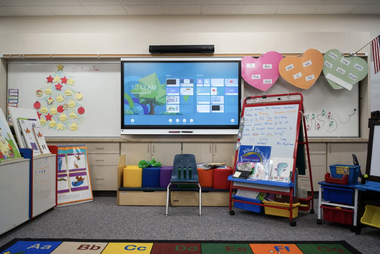
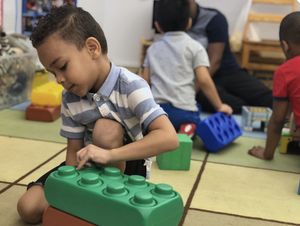
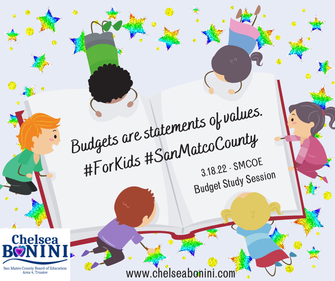

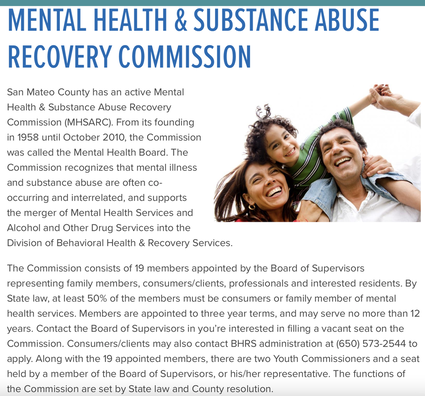
 RSS Feed
RSS Feed
